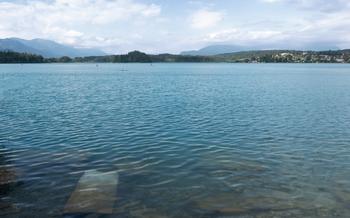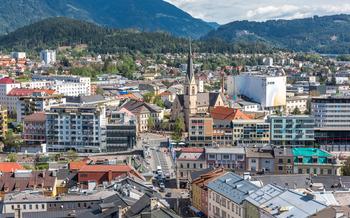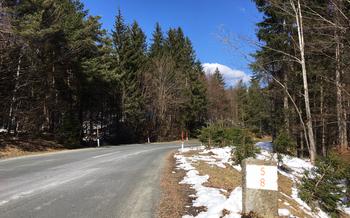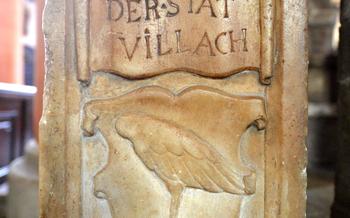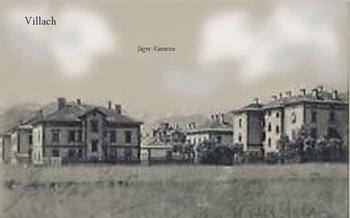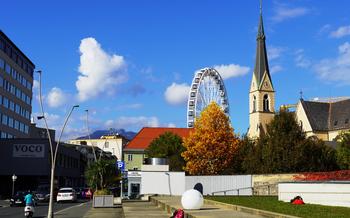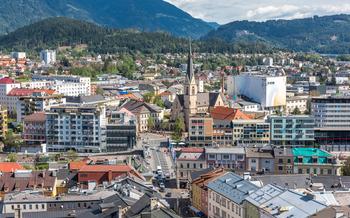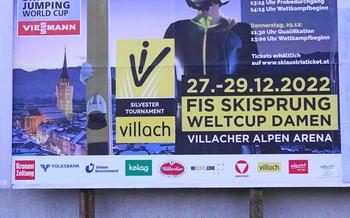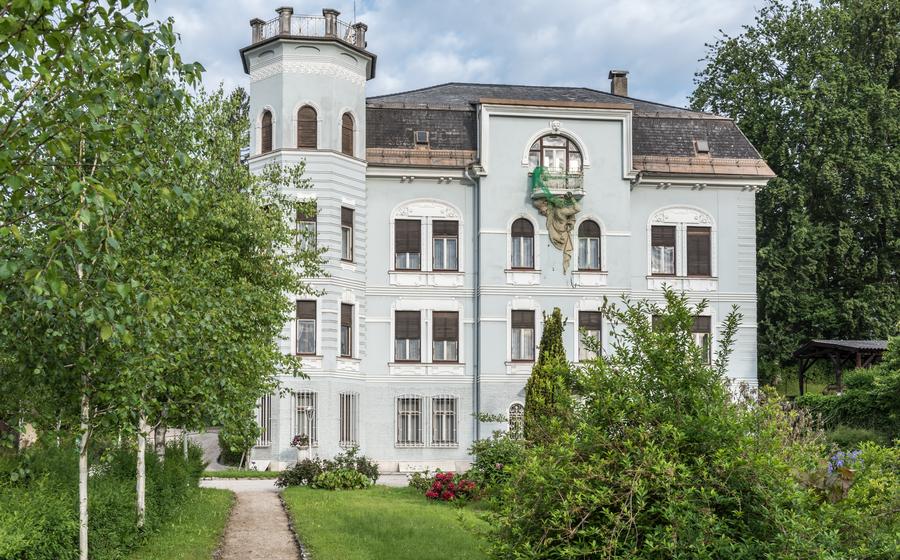
Villach Bunker Museum
- Villach Bunker Museum: A Journey into Austria's Wartime Past
- A Hidden Gem: Uncovering the Bunker's Secluded Location
- Preserving History: The Bunker's Transformation into a Museum
- Exploring the Bunker's Interior: A Glimpse into Wartime Life
- Interactive Exhibits: Engaging Visitors with History:
- Guided Tours: Unveiling the Bunker's Secrets
- Educational Programs: Fostering Understanding and Remembrance
- Personal Stories: Connecting with the Human Experience
- Remembrance Ceremonies: Honoring Those Who Served
- Research Opportunities: A Rich Source for Historians
- Community Involvement: A Bridge between Past and Present
- Artistic Expression: Interpreting War through Art
- Educational Resources: Facilitating Learning Beyond the Museum
- Accessibility and Facilities
- Insider Tip: Discover the Hidden Tunnel
Villach Bunker Museum: A Journey into Austria's Wartime Past
Wartime Significance of Villach: Nestled amidst the picturesque landscapes of Austria, the city of Villach played a pivotal role during World War II. Its strategic location near the Italian border made it a key target for air raids, leading to the construction of numerous air raid shelters and bunkers throughout the region.
Museum's Role in Preserving Memories: The Villach Bunker Museum stands as a testament to this turbulent period in history, serving as a poignant reminder of the challenges and sacrifices faced by the local population during the war. Through its carefully curated exhibits and interactive displays, the museum offers visitors a unique glimpse into the region's wartime experiences, preserving memories and fostering a deeper understanding of this critical chapter in Austrian history.
Unique Insights into Wartime Experiences: Beyond its historical significance, the Villach Bunker Museum provides a rare opportunity for visitors to gain firsthand insights into the daily lives of those who lived and worked in these underground shelters. Through interactive exhibits and guided tours, visitors can explore authentic recreations of living quarters, command centers, and medical facilities, gaining a deeper appreciation for the courage and resilience demonstrated by the local population during this challenging time.
A Hidden Gem: Uncovering the Bunker's Secluded Location
Amidst the breathtaking Austrian Alps, nestled in a peaceful valley, lies the Villach Bunker Museum. During World War II, this strategic location played a crucial role in protecting the region from enemy attacks. Secrecy and camouflage measures were meticulously employed to conceal the bunker's existence, ensuring its ability to withstand enemy surveillance and air raids. Today, the bunker stands as a testament to the resilience and ingenuity of the Austrian people during wartime. Its peaceful surroundings invite visitors to reflect on the tumultuous past and appreciate the tranquility of the present.
Reaching the museum is a journey in itself. Visitors can embark on a scenic drive through the picturesque Austrian countryside, marveling at the majestic Alpine peaks and lush forests. Alternatively, public transportation options are available, connecting visitors to the museum from nearby towns and cities. The journey to the Villach Bunker Museum is an experience that combines historical intrigue with the beauty of the Austrian landscape, setting the stage for a truly immersive and memorable visit.
Preserving History: The Bunker's Transformation into a Museum
After the war, the bunker fell into disuse and neglect. The passage of time and the elements took their toll on the structure, causing it to deteriorate and fade into obscurity. However, in the 1980s, a group of local historians and enthusiasts recognized the historical significance of the bunker and launched a campaign to restore and preserve it.
With the support of the local community and government, the bunker underwent extensive renovations. The original features of the structure were carefully restored, and a museum was established within its walls. The museum was designed to tell the story of the bunker's wartime past and to provide visitors with a unique insight into the experiences of the people who lived and worked there.
Through collaboration with historians, local communities, and survivors of the war, the museum was able to gather a wealth of artifacts, documents, and personal belongings that helped to bring the bunker's history to life. These items were carefully curated and displayed within the museum, creating a powerful and poignant memorial to the region's wartime experiences.
Exploring the Bunker's Interior: A Glimpse into Wartime Life
Venturing into the depths of the Villach Bunker Museum is like stepping back in time to the tumultuous years of World War II. The bunker's interior has been meticulously preserved, offering visitors an authentic and immersive experience of wartime life. Original features, such as ventilation systems, bunks, and command centers, have been left intact, creating an atmosphere of claustrophobia and tension that transports visitors to a bygone era.
Displays of wartime artifacts, documents, and personal belongings provide a tangible connection to the people who lived and worked in the bunker. These items include gas masks, uniforms, ration cards, and poignant letters that offer a glimpse into the everyday lives of those who sought refuge within these concrete walls. Recreations of living quarters, medical facilities, and command centers further enhance the immersive experience, allowing visitors to imagine the challenges and hardships faced by those who endured the war years in such confined and perilous conditions.
Interactive Exhibits: Engaging Visitors with History:
The Villach Bunker Museum offers a captivating array of interactive exhibits that bring the past to life and make history tangible for visitors of all ages. Multimedia presentations and virtual reality experiences transport visitors back in time, allowing them to witness firsthand the events that unfolded within the bunker's walls. Hands-on activities, such as simulations and puzzles, engage children and encourage them to explore the museum's exhibits in a fun and interactive way. Personal stories and testimonies from wartime survivors add a human dimension to the museum's displays, providing visitors with a glimpse into the lives of those who lived through this tumultuous period. These interactive elements not only enhance the museum experience but also foster a deeper understanding of the region's wartime history.
Guided Tours: Unveiling the Bunker's Secrets
To fully immerse yourself in the history of the Villach Bunker Museum, guided tours are highly recommended. Led by knowledgeable and passionate guides, these tours provide a deeper understanding of the bunker's construction, purpose, and significance. Visitors will gain insights into the lives of those who worked and lived within these walls, as well as the broader historical context of World War II in the region.
Tailored tours are available for different interests and age groups, ensuring that everyone can find a tour that suits their needs. For larger groups, advance booking is recommended to ensure availability. These guided tours not only bring the bunker's history to life but also offer a unique opportunity to ask questions and engage in discussions with experts.
Join a guided tour at the Villach Bunker Museum and embark on a journey through time, uncovering the secrets of this hidden gem and gaining a profound appreciation for the resilience and courage of those who lived through one of history's darkest chapters.
Educational Programs: Fostering Understanding and Remembrance
The Villach Bunker Museum is not just a place of remembrance; it is also a center for education and learning. The museum offers a range of educational programs designed to promote historical awareness and foster understanding of the impact of war.
Workshops, lectures, and educational materials are tailored to students of all ages, providing them with a deeper understanding of the events that unfolded during World War II. The museum collaborates with local schools to integrate its resources into history curricula, ensuring that the lessons of the past are not forgotten.
Encouraging intergenerational dialogue is a key aspect of the museum's educational mission. By bringing together wartime survivors, students, and the wider community, the museum creates a space for sharing personal stories and experiences, fostering empathy and understanding across generations.
Through these educational initiatives, the Villach Bunker Museum plays a vital role in preserving collective memory for future generations. It serves as a reminder of the human cost of war and the importance of promoting peace and reconciliation.
Personal Stories: Connecting with the Human Experience
The Villach Bunker Museum goes beyond showcasing historical facts and artifacts; it brings the past to life through the stories of individuals who lived and worked within its walls. Diaries, letters, and oral histories from survivors offer a poignant glimpse into the human toll of war and the resilience of the human spirit. These personal accounts shed light on the courage, sacrifice, and survival strategies of those who endured the hardships of wartime conditions.
One such story is that of Anna, a young nurse who volunteered at the bunker's medical facility. Her diary entries reveal the horrors she witnessed and the unwavering compassion she showed to the wounded and dying. Another is the story of Franz, a soldier who was stationed at the bunker and survived a near-death experience during an air raid. His account provides a firsthand perspective on the dangers faced by those who served on the front lines.
By sharing these personal stories, the Villach Bunker Museum fosters a deeper connection between visitors and the human experience of war. These narratives serve as a reminder of the devastating impact of conflict and the importance of preserving the memory of those who suffered and fought for a better future.
Remembrance Ceremonies: Honoring Those Who Served
The Villach Bunker Museum not only serves as a reminder of the past but also as a place to honor those who served and sacrificed during the war. Throughout the year, the museum hosts several remembrance ceremonies and events that pay tribute to their bravery and resilience.
The most prominent of these ceremonies is the annual commemoration held on the anniversary of the bunker's construction. On this day, representatives from the Austrian government, military officials, and local communities gather at the museum to lay wreaths, observe moments of silence, and deliver speeches honoring the memory of those who lost their lives.
These ceremonies are not just symbolic gestures; they are heartfelt expressions of gratitude and remembrance. They remind us of the immense sacrifices made by ordinary people during times of war and the importance of preserving their stories for generations to come.
By participating in these ceremonies, visitors can connect with the human side of history and gain a deeper appreciation for the courage and determination displayed by those who lived through the darkest days of World War II.
Research Opportunities: A Rich Source for Historians
The Villach Bunker Museum is not only a place of remembrance and education but also a valuable resource for historical research. Its extensive collection of documents, artifacts, and testimonies offers a wealth of information for scholars and researchers interested in the history of World War II and its impact on Austria.
The museum collaborates with universities and research institutions to facilitate access to its collection and promote historical research. Researchers can apply for access to the museum's archives, which include war diaries, maps, photographs, and personal accounts. The museum staff is available to assist researchers in their work and provide guidance on relevant sources.
The museum's collection has contributed to several historical publications and academic studies. Researchers have used the museum's resources to explore topics such as the role of the bunker in the region's air defense system, the experiences of civilians during the war, and the impact of the war on the local economy and society.
By providing access to its collection and collaborating with researchers, the Villach Bunker Museum plays a crucial role in advancing our understanding of the war and its lasting legacy. It serves as a valuable resource for historians seeking to uncover new insights into this significant period in Austrian history.
Community Involvement: A Bridge between Past and Present
The Villach Bunker Museum is not just a place of remembrance; it is also a vital part of the local community. The museum collaborates with local organizations and initiatives to preserve wartime memories and traditions. Oral history projects and community storytelling events allow residents to share their personal experiences and stories, creating a valuable historical record. The museum also works closely with local schools to promote historical awareness and encourage intergenerational dialogue about war and its consequences. Through these initiatives, the museum fosters a sense of ownership and pride in the region's history, bridging the gap between the past and the present.
Artistic Expression: Interpreting War through Art
The Villach Bunker Museum not only serves as a historical record but also as a platform for artistic expression. The museum collaborates with local artists and art collectives to showcase exhibitions that explore the themes of war, memory, and resilience through various artistic mediums. Paintings, sculptures, installations, and multimedia works offer visitors a unique perspective on the human experience during wartime. Artworks on display often draw inspiration from the bunker's history, artifacts, and personal stories. These exhibitions provide a powerful and evocative means of processing and expressing the complexities of war and its impact on individuals and communities. Through art, the museum encourages visitors to engage with the past in a creative and thought-provoking manner, fostering a deeper understanding of the human condition and the enduring legacy of war.
Educational Resources: Facilitating Learning Beyond the Museum
The Villach Bunker Museum extends its educational mission beyond its physical walls by offering a range of educational resources and materials for teachers and students. Online resources, including virtual tours and interactive content, provide remote access to the museum's exhibits and stories. These resources can be integrated into school curricula, allowing educators to incorporate the museum's valuable content into their lessons. Lesson plans and educational materials specifically designed for different age groups and curriculum requirements are also available. By providing these resources, the museum facilitates learning and encourages a deeper understanding of the historical events and themes it presents.
Accessibility and Facilities
The Villach Bunker Museum is committed to ensuring a welcoming and inclusive experience for all visitors. Accessibility features, such as ramps, elevators, and wheelchair-accessible restrooms, are in place to accommodate visitors with disabilities. Guided tours are available in multiple languages, including English, German, and Italian, to cater to international visitors.
Families with children are also welcome at the museum. A dedicated children's play area provides a space for young ones to engage in creative activities while parents explore the exhibits. The museum shop offers a range of souvenirs, books, and educational materials, including child-friendly items, to enhance the learning experience.
Insider Tip: Discover the Hidden Tunnel
Beyond the exhibits and guided tours, the Villach Bunker Museum holds a hidden secret – a tunnel that once served as a vital escape route during wartime. This tunnel, carved into the mountainside, provided a covert passage for soldiers and supplies, ensuring their safety in the face of imminent danger.
Today, visitors have the rare opportunity to explore this hidden tunnel, gaining a deeper understanding of the strategic importance of the bunker and the lengths to which people went to survive during wartime. Advance booking is recommended for tunnel tours, as they offer a unique and thrilling experience, allowing visitors to step back in time and experience a piece of history firsthand.

